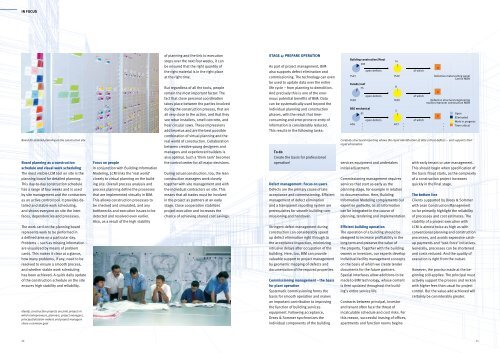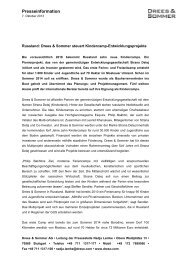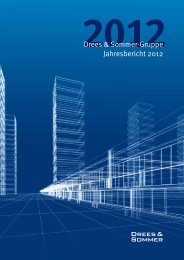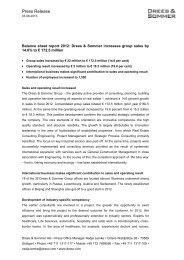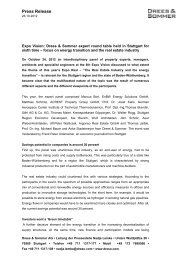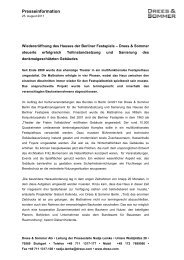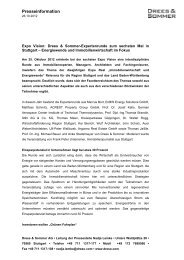Download Annual Report 2012 - Drees & Sommer
Download Annual Report 2012 - Drees & Sommer
Download Annual Report 2012 - Drees & Sommer
You also want an ePaper? Increase the reach of your titles
YUMPU automatically turns print PDFs into web optimized ePapers that Google loves.
IN FOCUS<br />
Board for detailed planning on the construction site<br />
Board planning as a construction<br />
schedule and visual work scheduling<br />
The most visible LCM tool on site is the<br />
planning board for detailed planning.<br />
This day-to-day construction schedule<br />
has a range of four weeks and is used<br />
by site management and the contractors<br />
as an active control tool. It provides detailed<br />
and stable work scheduling,<br />
and shows everyone on site the interfaces,<br />
dependencies and processes.<br />
The work card on the planning board<br />
represents work to be performed in<br />
a defined area on a particular day.<br />
Problems – such as missing information –<br />
are visualized by means of problem<br />
cards. This makes it clear at a glance,<br />
how many problems, if any, need to be<br />
resolved to ensure a smooth process,<br />
and whether stable work scheduling<br />
has been achieved. A quick daily update<br />
of the construction schedule on the site<br />
ensures high stability and reliability.<br />
Ideally, construction projects are joint projects in<br />
which entrepreneurs, planners, project managers,<br />
principal/decision-makers and project managers<br />
share a common goal<br />
Focus on people<br />
In conjunction with Building Information<br />
Modeling, LCM links the ‘real world’<br />
closely to virtual planning on the building<br />
site. Overall process analysis and<br />
process planning define the processes<br />
that are implemented virtually in BIM.<br />
This allows construction processes to<br />
be checked and simulated, and any<br />
bottlenecks and execution issues to be<br />
detected and resolved even earlier.<br />
Also, as a result of the high stability<br />
of planning and the link to execution<br />
steps over the next four weeks, it can<br />
be ensured that the right quantity of<br />
the right material is in the right place<br />
at the right time.<br />
But regardless of all the tools, people<br />
remain the most important factor: The<br />
fact that close personal coordination<br />
takes place between the parties involved<br />
during the construction process, that are<br />
all very close to the action, and that they<br />
see rebar installers, smell concrete, and<br />
hear circular saws. These impressions<br />
add impetus and are the best possible<br />
combination of virtual planning and the<br />
real world of construction. Collaboration<br />
between creative young designers and<br />
managers and experienced builders is<br />
also optimal. Such a ‘think tank’ becomes<br />
the control center for all major decisions.<br />
During actual construction, too, the lean<br />
construction managers work closely<br />
together with site management and with<br />
the individual contractors on site. This<br />
means that all trades must be involved<br />
in the project as partners at an early<br />
stage. Close cooperation stabilizes<br />
project execution and increases the<br />
chance of achieving shared cost savings.<br />
STAGE 4: PREPARE OPERATION<br />
As part of project management, BIM<br />
also supports defect elimination and<br />
commissioning. The technology can even<br />
be used to update data over the entire<br />
life cycle – from planning to demolition.<br />
And precisely this is one of the enormous<br />
potential benefits of BIM: Data<br />
can be systematically used beyond the<br />
individual planning and construction<br />
phases, with the result that timeconsuming<br />
and error-prone re-entry of<br />
information is considerably reduced.<br />
This results in the following tasks:<br />
To do<br />
Create the basis for professional<br />
operation!<br />
Defect management: Focus on users<br />
Defects are the primary cause of late<br />
acceptance and commissioning. Efficient<br />
management of defect elimination<br />
and a transparent reporting system are<br />
prerequisites for smooth building commissioning<br />
and handover.<br />
Stringent defect management during<br />
construction can considerably speed<br />
up defect elimination right through to<br />
the acceptance inspection, minimizing<br />
intrusive delays after occupation of the<br />
building. Here, too, BIM can provide<br />
valuable support to project management<br />
by geometric mapping of defects and<br />
documentation of the required properties.<br />
Commissioning management – the basis<br />
for plant operation<br />
Systematic commissioning forms the<br />
basis for smooth operation and makes<br />
an important contribution to improving<br />
the function of building services<br />
equipment. Following acceptance,<br />
<strong>Drees</strong> & <strong>Sommer</strong> synchronizes the<br />
individual components of the building<br />
Building construction/fitout<br />
1543<br />
283<br />
Facade/roof<br />
75<br />
1638<br />
BSE mechanical<br />
406<br />
91<br />
.<br />
.<br />
.<br />
open defects<br />
open defects<br />
open defects<br />
Carefully structured reporting allows the rapid identification of date critical defects – and supports their<br />
rapid elimination<br />
services equipment and undertakes<br />
initial adjustment.<br />
Commissioning management requires<br />
services that start as early as the<br />
planning stage, for example in relation<br />
to documentation. Here, Building<br />
Information Modeling complements our<br />
expertise perfectly, as all information<br />
can be integrated in the course of<br />
planning, tendering and implementation.<br />
Efficient building operation<br />
The operation of a building should be<br />
designed to increase profitability in the<br />
long term and preserve the value of<br />
the property. Together with the building<br />
owners or investors, our experts develop<br />
individual facility management concepts<br />
on the basis of which we create tender<br />
documents for the future partners.<br />
Special interfaces allow additions to be<br />
made to BIM technology, whose content<br />
is then updated throughout the building’s<br />
entire service life.<br />
Contracts between principal, investor<br />
and tenant often face the threat of<br />
incalculable schedule and cost risks. For<br />
this reason, successful leasing of offices,<br />
apartments and function rooms begins<br />
14<br />
1529<br />
8<br />
1630<br />
3<br />
403<br />
.<br />
.<br />
.<br />
of which<br />
of which<br />
of which<br />
3<br />
Defective metal ceiling panel<br />
Casino MBN<br />
2<br />
Defective structural engineering<br />
mullion/transom construction MBN<br />
2<br />
.<br />
.<br />
.<br />
Open<br />
Eliminated<br />
Work in progress<br />
Time-critical<br />
with early tenant or user management.<br />
This should begin when specification of<br />
the basic fitout starts, as the complexity<br />
of a construction project increases<br />
quickly in the final stage.<br />
The bottom line<br />
Clients supported by <strong>Drees</strong> & <strong>Sommer</strong><br />
with Lean Construction Management<br />
so far primarily highlight the reliability<br />
of processes and cost estimates. The<br />
stability of a project execution with<br />
LCM is almost twice as high as with<br />
conventional planning and construction<br />
processes, and avoids expensive catchup<br />
payments and ‘task-force’ initiatives.<br />
Generally, processes can be shortened<br />
and costs reduced. And the quality of<br />
execution is right from the outset.<br />
However, the proviso made at the beginning<br />
still applies: The principal must<br />
actively support the process and reckon<br />
with higher fees than usual for project<br />
control. But the value-add achieved will<br />
certainly be considerably greater.<br />
10<br />
11


